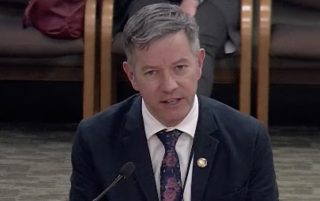
A key part of the City of Portland’s 2020 legislative agenda and traffic safety efforts got a boost in Salem yesterday when the Joint Committee on Transportation voted 10-2 in favor of House Bill 4103 which authorizes the Oregon Department of Transportation to delegate authority to set speed limits to cities and counties.
HB 4103 is a continuation of work that began last session by House Representative Rob Nosse, a Democrat who represents southeast Portland. Urged by the Portland Bureau of Transportation in their ongoing quest to lower speed limits and make roads safer, Nosse proposed a bill last year (HB 2702) that would have given Portland the ability to set speeds on certain streets in its jurisdiction. That bill didn’t make it out of committee, so Nosse continued discussions with ODOT and lawmakers and brought back a revised version this session.
“I believe we should be setting the speed limit based on how fast motorists should be driving in dense urban neighborhoods, not on how fast people want to drive.”
— Rob Nosse, state representative
The desire for more local control of speeds comes from widespread frustration with ODOT’s outdated methodology for responding to speed limit change requests. The cumbersome process can take up to six to nine months. And as I detailed in this example from 2018, ODOT uses a process to determine “safe” speeds that does the opposite of make streets safer because it’s based on the 85th percentile speed people are driving. That method has come under fire in recent years.
Portland has worked for over a decade to pry this power from ODOT’s hands.
In 2019 lawmakers gave cities the ability to decrease speed limits by 5 mph in certain circumstances, but they weren’t ready to relinquish speed setting authority altogether. Before doing so they wanted the state to update its administrative rules around determining speeds to provide guidance to the process and ensure statewide consistency. Now that the Oregon Transportation Commission is expected to pass those new rules at their meeting in March, lawmakers are following through with their promise to cities. The rules will mark the end of 85th percentile rule in some Oregon cities and will allow a more modern approach that reflects road context and dense, urban environments.
Speaking in favor of the bill at a committee hearing on February 4th, Rep. Nosse said, “In a big city like mine, where there are more and more people, more and more cars, more traffic — the local jurisdiction needs to be the one to take responsibility for figuring out how fast someone should be allowed to drive.” He also took a swipe at the 85 percentile method (which ODOT will continue to use on non-urban roadways) and added, “I believe we should be setting the speed limit based on how fast motorists should be driving in dense urban neighborhoods, not on how fast people want to drive.”
The new law would be effective October 1st 2020 and would apply only to two counties: Lane and Multnomah. Nosse said his bill last session included all counties but he found that not everyone wanted — or is prepared to handle — the additional authority. Also keep in mind that it doesn’t apply to state-owned roads and highways like 82nd, Powell or McLoughlin.
Advertisement
The bill is supported by ODOT. ODOT Delivery and Operations Deputy Administrator Mac Lynde acknowledged “It has not been an easy conversation” with cities; but he feels they’ve built in enough guidance into the law to make sure any city that participates is up to the task. ODOT will have the right to rescind the delegation if a local agency doesn’t adhere to requirements around documentation, staffing, signage, notification, and so on.
For Transportation Committee member Senator Sara Gelser (D-Corvallis), the change can’t come soon enough. “Unfortunately, since the last time we were here and we heard from the parent of an individual that had been killed in a crosswalk on SW 3rd Street, we’ve now had the third fatality in that same crosswalk in an 18-month period. And that was an 11-year-old girl.”
The only person to oppose the bill at the hearing was Waylon Buchan, director of government affairs for the Oregon Trucking Associations. “I can understand [a city’s] desire for increased local control when they see a problem in their neighborhood, but we need to balance that with benefits we get with a big, holistic view of the entire state.” Buchan said he wants drivers to be able to go as fast as possible. “Five miles per hour here, 10 mph there, across the entire nation, it’s going to add up. We do care about speed and efficiency in getting you your freight.”
At last night’s work session, only two lawmakers out of 12 on the committee voted against it. Rep. Shelly Boshart Davis (R-Albany) said she thinks the bill is just “doubling-up” on the process. “We’re just adding to what ODOT is already capable of doing,” she said. And Rep. Brian Witt (D-Clatskanie) issued a vague criticism: “The City of Portland on a regular basis demonstrates its abuse of its power to regulate traffic in my district and I am not prepared to give them any additional authority.” (I’ve asked him for clarification and will update when I hear back.)
From here, the bill goes directly to floor votes. If it passes it will culminate an 11 year effort by the City of Portland that started in 2009 with a letter to ODOT from then-PBOT Commissioner Sam Adams.
Follow HB 4103 on OLIS.
— Jonathan Maus: (503) 706-8804, @jonathan_maus on Twitter and jonathan@bikeportland.org
— Get our headlines delivered to your inbox.
— Support this independent community media outlet with a one-time contribution or monthly subscription.

